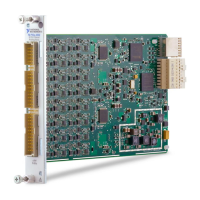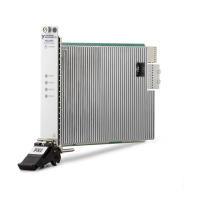PXIe-4468 Calibration Procedure
14 ni.com/services
Rate 250000
Samples per channel 125000
*Refer to Table 3 for the maximum and minimum voltages to specify to ensure the
specified gain range is used on the module.
4. Start the task.
5. Acquire readings with the DUT.
6. Calculate the RMS amplitude of the acquired fundamental harmonic.
Compare this amplitude to the appropriate voltage limits in Table 4.
The calculated amplitude is used to verify the gain accuracy of the
channel under test at the tested gain setting.
As an example, use the Extract Single Tone Information VI to help
calculate RMS. Note that the output of this VI is peak amplitude, and
must be divided by √2 to convert to RMS.
7. Stop and clear the task.
AI Gain Flatness Verification
Test Limits
Table 6:
AI Flatness Verification Limits
Device Gain (dB)
Calibrator
Output
Frequency (kHz)
As-Found Test Limit
Lower Limit Upper Limit
-10 and -20
1 V
1kHz
20 0.97724 * V
1kHz
1.02329 * V
1kHz
45 0.93325 * V
1kHz
1.07152 * V
1kHz
100 0.89125 * V
1kHz
1.12202 * V
1kHz
0, 10, 20 and 30 1 V
1kHz

